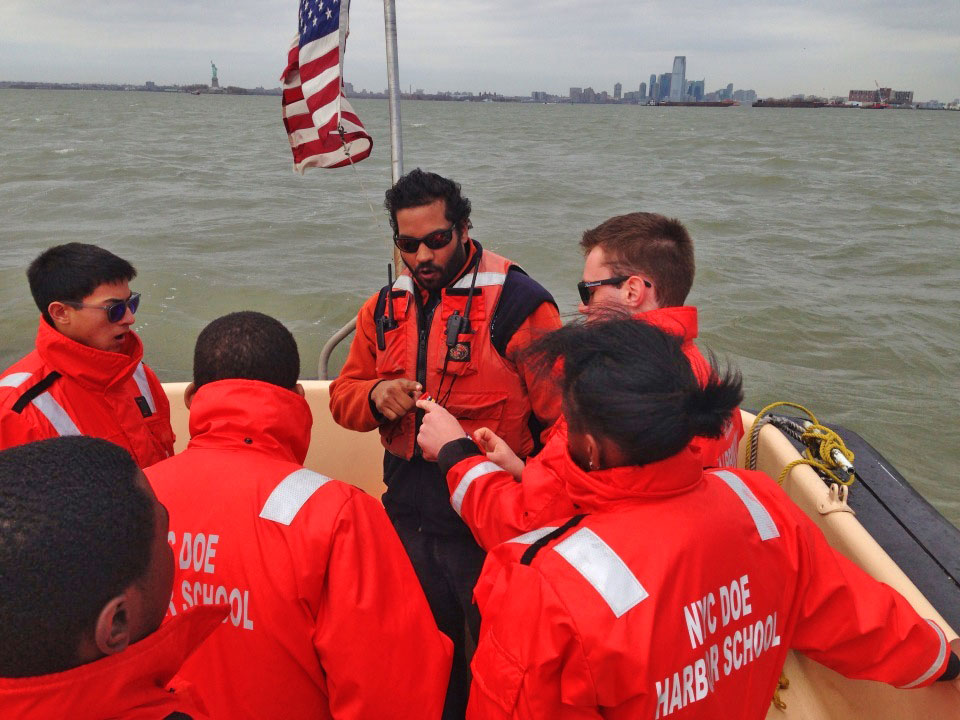Editor’s note: This is the fourth in a series of mariner interviews conducted by Kim Carver.
Kim Carver: In two sentences, could you please explain what the New York Harbor School is about to someone who has never heard of it?
Capt. Aaron Singh: New York Harbor School is a public, maritime high school located on Governors Island. As a Career and Technical Education (CTE) school, we prepare students for going to college and for working in the maritime industry.
KC: Describe how you ended up working in the maritime industry, and why you wanted the job at the New York Harbor School.
Capt. Singh: My love of the water began with the Sea Scouts program where we were sailing a 34' sloop out of City Island in the Bronx. One of the requirements of the Sea Scout program was to also sail on a schooner, ketch or yawl. This requirement led me to seek out the volunteer program at the South Street Seaport Museum. South Street is well known for grooming future mariners and I was no exception. My love of the water started with sailing, but it expanded and deepened as I learned more about the industry. I have been fortunate to sail on tall ships, small ships, speedboats, and slow boats — the whole gamut. Over the years I have worked on boats for the tourist industry and for education purposes. I think that experience actually allows me to connect industry to all my students that are in my CTE vessel operations program. I have had a passion to introduce New York City youth to maritime careers for a long time. And when the Harbor School was founded in 2003 I was working for South Street Seaport as the captain of Lettie G. Howard, which was Harbor School’s first classroom on the water. The students’ very first experience out on the water was with me on Lettie. In the years following I worked on several other boats, but always kept a close eye on what the Harbor School was up to. When the school was moving out to Governors Island in 2010 they had decided to formalize six Career and Technical Education Programs (CTE) and a position opened up for a vessel operations instruction. For me, it was a dream job. It allowed me to create, from scratch, a six-semester maritime high school curriculum that gives students the experience and credentials they need to be able to graduate and enter the marine field if they so choose. What’s incredible about creating this curriculum for me as a lifelong learner is that it has allowed me meet new people across the board in the marine industry from the Sandy Hook Pilots to Coast Guard to the Department of Transportation to Kirby to Hornblower to Circle Line. I find it really exciting that this curriculum allows students to interact with the industry as a whole. And as a boat geek I have been able to learn side by side with my students and deepen my knowledge with the many different facets of the industry that I didn’t previously have experience with. Since becoming a teacher I have, for example, learned techniques for taking a pilot exam and learned the right way to service an Aid to Navigation with a buoy tender.
KC: Along with all of the regular courses, the school offers extensive learning in several maritime related fields. A student has options to learn about aquaculture, marine research, marine trades and ocean engineering. The maritime industry needs skilled workers more than ever. Why do you believe NYHS is the only high school in the country preparing teens to fill these positions?
Capt. Singh: I wouldn’t say we’re the only high school in the country. My students and I were fortunate to have been given the opportunity to give a presentation about maritime high schools at the Tall Ship America conference last February. We found out that there are over 25 maritime-themed high schools in the U.S. But despite the fact that many schools have made forays into maritime education, Harbor School has taken the “theme” to a much higher level by offering more than 60 percent of our vessel ops class time on the water. This time on the water gives students sea time and hands-on experience with our Coast Guard inspected vessels.
KC: In regards to the students that choose a maritime career, some will likely attend a maritime academy. For those who opt out of that, what jobs might these particular 18-year-old graduates be prepared for, based on a focus on Marine Biology Research, Marine Systems Technology, Ocean Engineering, Scientific Diving and/or Vessel Ops?
Capt. Singh: In addition to that our program allows our students to get in-house credentials, which makes them employable and desirable when they graduate. These credentials include the New York State Safe Boating course, U.S. Powerboating, Coast Guard Launch Operator course certificate, FCC marine radio operator permit, Red Cross First Aid and CPR, TWIC card, and placements in marine internships at multiple times throughout their high school career. Each of the other five CTE programs has similar opportunities for their students within the parameters of their program. The beauty of the vessel ops program is that it’s integrated into the six semesters, and students are already connected to the marine industry through our work based learning internships. About 95 percent of vessel ops students have stayed employed with their internship site after graduation. We have also been finding that students who graduate and are undecided about what to do next, come back to the marine industry and specifically come back their internship sites three to four years later. An interesting statistic is that in New York Harbor 80 percent of all of the maritime positions are held by non-New Yorkers. One of the goals of Harbor School is to change that. I want to inform and connect urban youth with their maritime industry.
KC: Anything else you want the world to know about what you're doing at NYHS right now?
Capt. Singh: One of the really exciting things we have going on at Harbor School right now is that Lettie G. Howard (the tall ship that the first Harbor School students sailed on) is part of the students’ school experience again. Through a collaboration with the South Street Seaport Museum, the Port Authority of New York and New Jersey and the New York Harbor Foundation, Lettie has had her first season sailing with students in several years. Harbor School students and staff, alongside South Street Seaport Museum volunteers brought Lettie back from a major refit in Portland, Maine, last winter and worked to get her ready to sail throughout the winter and spring. Harbor School students who are in the vessel operations and marine systems technology CTE programs got hands-on experience completing jobs such as putting up the winter cover, repitching the deck, rigging the boat, putting up the topmast and getting all the engineering squared away. It was Harbor School students that worked directly with the Coast Guard to get Lettie’s COI reinstated. This season, Lettie has had hundreds of visitors on board for deck tours and has also gone sailing with students from the Harbor School and Maritime Academy of Science and Technology in Sandy Hook, N.J. We are working under the motto “Two States, One Port” and emphasizing the connection between these two maritime schools and their students that have a great deal to learn from each other. It’s a really exciting relationship that the schools are forming.
Check out the Harbor School documentary and other Harbor School video.




